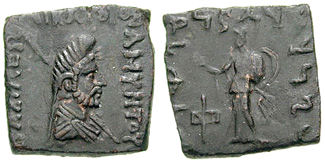Amyntas Nikator
| Amyntas | |
|---|---|
 Portrait of young Amyntas | |
| Indo-Greek king | |
| Reign | 95–90 BCE |



Amyntas Nikator (Greek: Ἀμύντας ὁ Νικάτωρ; epithet means "the Conqueror") was an Indo-Greek king. His coins have been found both in eastern Punjab and Afghanistan, indicating that he ruled a considerable territory.
Time of reign[]
Bopearachchi places Amyntas c. 95–90 BCE, whereas Senior places him c. 80–65 BCE.
Coinage[]
Amyntas struck bilingual silver coins with a variety of portraits. Most of these bear the reverse of sitting Zeus holding a victory palm and a small statue of Athena, which according to RC Senior may have indicated an alliance between the house of Menander I and the house of Antialcidas. Some of his coins feature the reverse of fighting Athena typical for Menander's descendants. The epithet Nikator (Victor) was previously only used on the Bactrian coins of Agathocles, a century before Amyntas' reign.
His bronzes feature the syncretic deity Zeus-Mithra wearing a phrygian cap and Athena standing at rest, both forming the vitarka mudra.
Amyntas also minted some spectacular Attic coins, the largest silver coins of Antiquity: double-decadrachms, of a weight of 85g. These huge coins were found on the archeological site of Qunduz in Afghanistan. Some of these coins use his ordinary Zeus reverse, but some of them used Tyche in an identical position.
Overstrikes[]
Amyntas is known to have overstruck coins of Heliokles II.[1]
| Greco-Bactrian kings | Indo-Greek kings | |||||||||||
| Territories/ dates |
West Bactria | East Bactria | Paropamisade |
Arachosia | Gandhara | Western Punjab | Eastern Punjab | Mathura[3] | ||||
| 326-325 BCE | Campaigns of Alexander the Great in India | Nanda Empire | ||||||||||
| 312 BCE | Creation of the Seleucid Empire | Creation of the Maurya Empire | ||||||||||
| 305 BCE | Seleucid Empire after Mauryan war | Maurya Empire | ||||||||||
| 280 BCE | Foundation of Ai-Khanoum | |||||||||||
| 255–239 BCE | Independence of the Greco-Bactrian kingdom Diodotus I |
Emperor Ashoka (268-232) | ||||||||||
| 239–223 BCE | Diodotus II | |||||||||||
| 230–200 BCE | Euthydemus I | |||||||||||
| 200–190 BCE | Demetrius I | Sunga Empire | ||||||||||
| 190-185 BCE | Euthydemus II | |||||||||||
| 190–180 BCE | Agathocles | Pantaleon | ||||||||||
| 185–170 BCE | Antimachus I | |||||||||||
| 180–160 BCE | Apollodotus I | |||||||||||
| 175–170 BCE | Demetrius II | |||||||||||
| 160–155 BCE | Antimachus II | |||||||||||
| 170–145 BCE | Eucratides I | |||||||||||
| 155–130 BCE | Yuezhi occupation, loss of Ai-Khanoum |
Eucratides II Plato Heliocles I |
Menander I | |||||||||
| 130–120 BCE | Yuezhi occupation | Zoilos I | Agathokleia | Yavanarajya inscription | ||||||||
| 120–110 BCE | Lysias | Strato I | ||||||||||
| 110–100 BCE | Antialcidas | Heliokles II | ||||||||||
| 100 BCE | Polyxenos | Demetrius III | ||||||||||
| 100–95 BCE | Philoxenus | |||||||||||
| 95–90 BCE | Diomedes | Amyntas | Epander | |||||||||
| 90 BCE | Theophilos | Peukolaos | Thraso | |||||||||
| 90–85 BCE | Nicias | Menander II | Artemidoros | |||||||||
| 90–70 BCE | Hermaeus | Archebius | ||||||||||
| Yuezhi occupation | Maues (Indo-Scythian) | |||||||||||
| 75–70 BCE | Vonones | Telephos | Apollodotus II | |||||||||
| 65–55 BCE | Spalirises | Hippostratos | Dionysios | |||||||||
| 55–35 BCE | Azes I (Indo-Scythians) | Zoilos II | ||||||||||
| 55–35 BCE | Vijayamitra/ Azilises | Apollophanes | ||||||||||
| 25 BCE – 10 CE | Gondophares | Zeionises | Kharahostes | Strato II Strato III |
||||||||
| Gondophares (Indo-Parthian) | Rajuvula (Indo-Scythian) | |||||||||||
| Kujula Kadphises (Kushan Empire) | Bhadayasa (Indo-Scythian) |
Sodasa (Indo-Scythian) | ||||||||||
See also[]
- Greco-Bactrian Kingdom
- Seleucid Empire
- Greco-Buddhism
- Indo-Scythians
- Indo-Parthian Kingdom
- Kushan Empire
References[]
- ^ Bopearachchi, Osmund (2003). De l'Indus à l'Oxus, Archéologie de l'Asie Centrale (in French). Lattes: Association imago-musée de Lattes. p. 129. ISBN 2-9516679-2-2.
- ^ O. Bopearachchi, "Monnaies gréco-bactriennes et indo-grecques, Catalogue raisonné", Bibliothèque Nationale, Paris, 1991, p.453
- ^ Quintanilla, Sonya Rhie (2 April 2019). "History of Early Stone Sculpture at Mathura: Ca. 150 BCE - 100 CE". BRILL – via Google Books.
Further reading[]
- Tarn, W. W. (1984). The Greeks in Bactria and India. Chicago: Ares. ISBN 0-89005-524-6.
- Narain, A.K. (1976). The Coin Types of the Indo-Greek Kings, 256–54 B.C. Chicago. ISBN 0-89005-109-7.
External links[]
- Indo-Greek kings
- 1st-century BC rulers in Asia